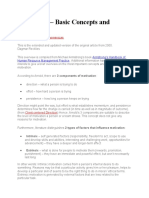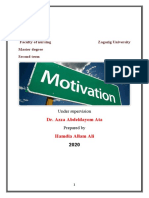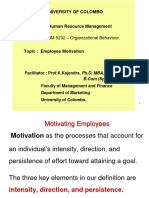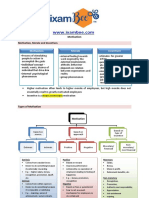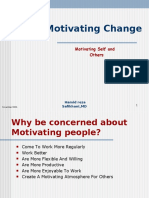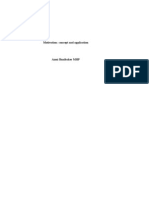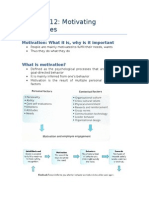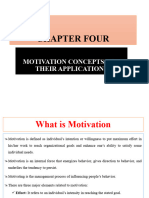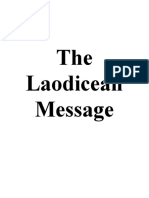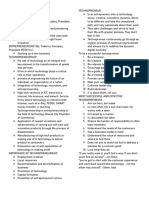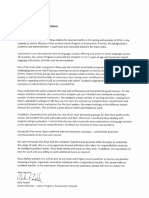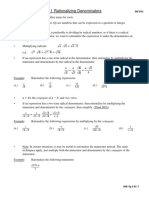Introduction to Motivation
Motivation is a complex and multifaceted phenomenon, often defined using terms like drives, goals, desires, and needs. It
involves the intensity, direction, and persistence of effort toward achieving a goal. Motivation is situational and varies across
individuals and contexts. Understanding what motivates people equips managers with a powerful tool to inspire
performance. Motivating employees involves a blend of communication , leadership, feedback, and rewards. It acts as a
catalyst, determining the level of effort individuals put forth to achieve personal and organizational objectives.
Process of Motivation
Motivation begins with identifying a need, which could be physiological (e.g., food, water) or psychological (e.g., recognition ,
self-esteem). This unmet need creates tension, prompting individuals to seek ways to address it. They engage in goal-
directed actions, utilizing their skills and available resources to bridge the gap between their current state and desired
outcome. If the effort results in performance that is appropriately rewarded, the cycle culminates in need satisfaction .
Subsequently, the individual reassesses their needs, restarting the process as new desires emerge.
Approaches to Motivation
Motivational theories are divided into cognitive and non-cognitive models. Cognitive models focus on the internal mental
processes influencing behavior, while non-cognitive models emphasize external factors like rewards and punishments. These
models are not mutually exclusive and often work together to influence employee actions.
• Cognitive Models :
• Content Theories examine the factors that energize and direct behavior, such as internal needs and desires.
Examples include Maslow’s Hierarchy of Needs and McClelland’s Theory of Needs.
• Process Theories focus on how behavior is initiated and sustained through decision-making processes, such as
Vroom’s Expectancy Theory and Equity Theory.
• Non-Cognitive Models :
These models suggest that behavior is influenced by external factors. For instance, positive reinforcement encourages
desired actions, while punishments deter undesirable behaviors.
Maslow’s Need Hierarchy Theory
Abraham Maslow proposed a hierarchy of needs arranged in ascending order, starting with basic physiological needs and
culminating in self-actualization .
• Physiological Needs: Basic survival needs like food, water, and shelter.
• Safety Needs: Security and stability, such as job security and health insurance.
• Social Needs: Belongingness and relationships with peers and loved ones.
• Esteem Needs: Internal aspects like self-respect and external recognition .
• Self-Actualization: Personal growth and achieving one’s full potential .
The theory suggests that lower-order needs must be met before higher-order needs become motivational . While widely
accepted, it is criticized for its cultural limitations and assumption of a rigid hierarchy.
McClelland’s Theory of Needs
David McClelland identified three primary needs that shape behavior:
• Need for Achievement (nAch) : The drive to excel and achieve challenging goals.
• Need for Power (nPow) : The desire to influence or control others.
• Need for Affiliation (nAff) : The desire for close, friendly relationships.
Individuals display varying levels of these needs, influencing their preferences for roles and tasks. Managers can use this
understanding to tailor strategies for motivation .
Alderfer’s ERGTheory
Alderfer refined Maslow’s hierarchy into three categories:
• Existence Needs: Basic survival and safety requirements.
• Relatedness Needs: Social relationships and connections.
• Growth Needs: Personal development and self-actualization .
The ERGtheory allows for flexibility, suggesting that multiple needs can operate simultaneously. It also introduces the
concept of frustration-regression, where unmet higher-level needs intensify lower-level needs.
�Herzberg’s Two-Factor Theory
Frederick Herzberg categorized workplace factors into hygiene factors and motivators. Hygiene factors, such as salary and
working conditions , prevent dissatisfaction but do not lead to motivation . Motivators, such as recognition and achievement,
drive satisfaction and motivation . Herzberg’s theory emphasizes job enrichment and the importance of intrinsic motivators
but is criticized for its limited applicability across different professions.
Theory X and Theory Y
Douglas McGregor identified two managerial perspectives on employee motivation :
• Theory X assumes employees dislike work, lack ambition , and require supervision and coercion. Managers using this
approach rely on rewards and punishments to drive performance.
• Theory Y assumes employees are self-motivated, capable, and committed . This perspective aligns with higher-order
needs, like self-actualization and esteem, as drivers of motivation .
Vroom’s Expectancy Theory
Victor Vroom’s theory explains motivation as a product of three components:
• Expectancy: The belief that effort will lead to performance.
• Instrumentality: The belief that performance will lead to rewards.
• Valence: The value placed on the rewards.
Motivation is calculated as the product of these components. If any one of them is zero, motivation diminishes. Conversely,
higher scores across all components result in stronger motivation .
Equity Theory
J.S. Adams’ Equity Theory highlights the importance of fairness in the workplace. Employees compare their input-output ratio
(effort vs. rewards) to others. Perceived inequities can lead to decreased effort, demands for greater rewards, or intentions to
leave the organization. Managers must ensure equitable treatment to maintain employee motivation and engagement.
Intrinsic and Extrinsic Motivation
Cognitive evaluation theory distinguishes between:
• Intrinsic Motivation : Driven by internal factors like personal satisfaction or curiosity.
• Extrinsic Motivation : Influenced by external rewards such as pay or recognition .
Both forms of motivation contribute to workplace performance, with intrinsic motivation fostering deeper engagement and
satisfaction .
